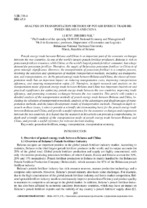| dc.description.abstract | Potash energy trade between Belarus and China is an important part of the economic exchanges between the two countries. As one of the world's largest potash fertilizer producers, Belarus is rich in potassium fertilizer resources, while China, as the world's largest potash fertilizer consumer, has a huge demand for potassium fertilizer. Therefore, the supply of Belarusian potassium fertilizer to China is of great strategic significance. However, the transportation of potassium fertilizer is a complex process, involving the selection and optimization of multiple transportation methods, including sea transportation, rail transportation, etc. In the potash energy trade between Belarus and China, the choice of trans-portation mode has an important impact on reducing transportation costs, improving transportation efficiency, and ensuring transportation safety [1]. Therefore, in-depth research and analysis on the transportation mode of potash energy trade between Belarus and China has important theoretical and practical significance for optimizing potash energy trade between the two countries, improving trade efficiency, and promoting economic exchanges between the two countries. This article will conduct a detailed analysis of the transportation methods of potash energy trade between Belarus and China, including the selection of transportation methods, analysis of the advantages and disadvantages of transportation methods, and the future development trends of transportation methods. Through in-depth research on these issues, it aims to provide a scientific decision-making basis for the potash energy trade between Belarus and China, and provide a useful reference for the economic exchanges and cooperation between the two countries. It is hoped that the research in this article can provide a comprehensive, in-depth and scientific analysis of the transportation mode of potash energy trade between Belarus and China, and provide a useful reference for relevant decision-making. | ru |

